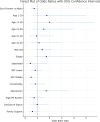Predictors of virological outcomes in patients with HIV on antiretroviral therapy in Osogbo, Nigeria: a cross-sectional study
- PMID: 40413409
- PMCID: PMC12102910
- DOI: 10.1186/s12879-025-11084-1
Predictors of virological outcomes in patients with HIV on antiretroviral therapy in Osogbo, Nigeria: a cross-sectional study
Abstract
Background: Virological outcome is a critical determinant of care in HIV management, as highlighted in the third portion of the UNAIDS 95-95-95 fast-track targets, emphasizing viral load suppression as an essential strategy for epidemiological control of HIV by 2030. There have been various reports regarding Nigeria's recent position, particularly concerning viral load suppression. This study aimed to determine the virological outcomes and associated predictors among HIV-infected individuals on highly active antiretroviral therapy (HAART) in three treatment facilities in Osogbo, Southwest Nigeria.
Methodology: This descriptive cross-sectional study involved 830 HIV-infected participants recruited from three treatment facilities in Osogbo, Nigeria, over eight months. The participants completed a proforma documenting their sociodemographic and clinical details as well as their responses to questions about HIV care (independent variables). Blood samples were collected for HIV viral load assays, with results defined as good (< 1000 copies/ml) or poor (≥ 1000 copies/ml) virological outcomes. The data obtained were analyzed using the Statistical Package for Social Sciences (SPSS) version 23. Associations between dependent (good and poor virological outcomes) and independent variables were assessed using bivariate analysis (Pearson's chi-square test). Multivariate analysis (binomial regression) was employed to determine predictors of virological outcomes. Statistical significance was set at a P value < 0.05, and confidence intervals were calculated at 95%.
Results: The prevalence rates of poor and good virological outcomes were 15.54% and 84.46%, respectively. Predictors of virological outcomes included residential status, socioeconomic status (middle), adherence to HAART, knowledge of HIV medications and their side effects, comorbidity status, depression, pill quantity, disclosure status, family support, stigma, and discrimination (p < 0.05).
Conclusion: Although the good virological outcome (suppression) prevalence still fell short of the advocated 95%, improving adherence counseling, increasing financial empowerment to ease transportation costs to clinics, and eliminating stigmatization and discrimination in care are needed to enhance and sustain the HIV response.
Keywords: Antiretroviral; HIV; Outcomes; Predictors; Virological.
© 2025. The Author(s).
Conflict of interest statement
Declarations: Ethical approval and consent to participate. Ethical approval for this study was obtained from the Ethics and Research Committee of the three hospitals; the Research Ethics Committee of Osun State University Teaching Hospital, Osogbo; the Specialist Hospital Osogbo Research Ethics Committee; and the Ethical Committee on Research, Our Lady of Fatima Catholic Hospital, Osogbo, with the registration numbers UTH/REC/2023/02/745 and HREC/27/04/2015/SSHO/782. The study adhered to the Declaration of Helsinki. Written informed consent was obtained from the adult participants and the parents/guardians of participants under 16 years of age (minor). The minor participants also provided verbal assent. The purpose of the study was emphasized, and other details regarding the study were explained to them. Each participant was identified by a serial number decoded only by the researcher. The serial number was written on each participant’s proforma and investigation items. All information obtained from each participant was kept on a computer with a password known only to the researcher. Consent for publication: Not applicable. Competing interests: The authors declare no competing interests.
Figures
References
-
- World Health Organisation. HIV and AIDS. Key facts 2024. Available at https://www.who.int/news-room/fact-sheets/detail/hiv. Assessed 15th October, 2024.
-
- UNAIDS. Global HIV Statistics. Fact Sheet 2024. Available at: https://www.unaids.org/sites/default/files/media_asset/UNAIDS_FactSheet_... .Accessed 10th October, 2024.
-
- UNAIDS. Country Reports 2018—Nigeria. Available at: https://www.unaids.org/en/regionscountries/countries/nigeria. Accessed 28th October, 2024.
-
- Ochie KM, Eze FN. Towards 95–95-95: A Review Of The Last Decade Of HIV Viral Suppression In Nigeria. Afr J Pharm Res Dev. 2023;15(3):23–34.
MeSH terms
Substances
LinkOut - more resources
Full Text Sources
Medical



